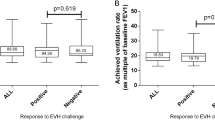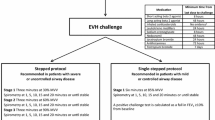Abstract
Background
Exercise-induced bronchoconstriction (EIB) has not been well studied in cystic fibrosis (CF), and eucapnic voluntary hyperventilation (EVH) testing has not been used as an objective assessment of EIB in CF to date.
Methods
A prospective cohort pilot study was completed where standard EVH testing was completed by 10 CF patients with forced expiratory volume in 1 s (FEV1) ≥70 % of predicted. All patients also completed a cardiopulmonary exercise test (CPET) with pre- and post-CPET spirometry as a comparative method of detecting EIB.
Results
No adverse events occurred with EVH testing. A total of 20 % (2/10) patients were diagnosed with EIB by means of EVH. Both patients had clinical symptoms consistent with EIB. No patient had a CPET-based exercise challenge consistent with EIB.
Conclusions
EVH testing was safe and effective in the objective assessment for EIB in patients with CF who had well-preserved lung function. It may be a more sensitive method of detecting EIB then exercise challenge.

Similar content being viewed by others
References
Parsons JP, Hallstrand TS, Mastronarde JG, Kaminsky DA, Rundell KW, Hull JH, Storms WW, Weiler JM, Cheek FM, Wilson KC, Anderson SD (2013) An official American Thoracic Society clinical practice guideline: exercise-induced bronchoconstriction. Am J Respir Crit Care Med 187(9):1016–1027. doi:10.1164/rccm.201303-0437ST
Balfour-Lynn IM (2003) Asthma in cystic fibrosis. J R Soc Med 96(Suppl 43):30–34
Mellis CM, Levison H (1978) Bronchial reactivity in cystic fibrosis. Pediatrics 61(3):446–450
Flume PA, O’Sullivan BP, Robinson KA, Goss CH, Mogayzel PJ Jr, Willey-Courand DB, Bujan J, Finder J, Lester M, Quittell L, Rosenblatt R, Vender RL, Hazle L, Sabadosa K, Marshall B (2007) Cystic fibrosis pulmonary guidelines: chronic medications for maintenance of lung health. Am J Respir Crit Care Med 176(10):957–969. doi:10.1164/rccm.200705-664OC
Jones A, Bowen M (1994) Screening for childhood asthma using an exercise test. Br J Gen Pract 44(380):127–131
Parsons JP, Mastronarde JG (2005) Exercise-induced bronchoconstriction in athletes. Chest 128(6):3966–3974. doi:10.1378/chest.128.6.3966
Nielsen KG, Bisgaard H (2005) Hyperventilation with cold versus dry air in 2- to 5-year-old children with asthma. Am J Respir Crit Care Med 171(3):238–241. doi:10.1164/rccm.200404-528OC
Hurwitz KM, Argyros GJ, Roach JM, Eliasson AH, Phillips YY (1995) Interpretation of eucapnic voluntary hyperventilation in the diagnosis of asthma. Chest 108(5):1240–1245
Anderson SD, Argyros GJ, Magnussen H, Holzer K (2001) Provocation by eucapnic voluntary hyperpnoea to identify exercise induced bronchoconstriction. Br J Sports Med 35(5):344–347
Brummel NE, Mastronarde JG, Rittinger D, Philips G, Parsons JP (2009) The clinical utility of eucapnic voluntary hyperventilation testing for the diagnosis of exercise-induced bronchospasm. J Asthma 46(7):683–686. doi:10.1080/02770900902972178
Miller MR, Hankinson J, Brusasco V, Burgos F, Casaburi R, Coates A, Crapo R, Enright P, van der Grinten CP, Gustafsson P, Jensen R, Johnson DC, MacIntyre N, McKay R, Navajas D, Pedersen OF, Pellegrino R, Viegi G, Wanger J (2005) Standardisation of spirometry. Eur Respir J 26(2):319–338. doi:10.1183/09031936.05.00034805
Ross RM (2003) ATS/ACCP statement on cardiopulmonary exercise testing. Am J Respir Crit Care Med 167(10):1451. doi:10.1164/ajrccm.167.10.952 author reply 1451
Schneiderman-Walker J, Pollock SL, Corey M, Wilkes DD, Canny GJ, Pedder L, Reisman JJ (2000) A randomized controlled trial of a 3-year home exercise program in cystic fibrosis. J Pediatr 136(3):304–310. doi:10.1067/mpd.2000.103408
Orenstein DM, Higgins LW (2005) Update on the role of exercise in cystic fibrosis. Curr Opin Pulm Med 11(6):519–523
Nixon PA, Orenstein DM, Kelsey SF, Doershuk CF (1992) The prognostic value of exercise testing in patients with cystic fibrosis. N Engl J Med 327(25):1785–1788. doi:10.1056/NEJM199212173272504
Boucher GP, Lands LC, Hay JA, Hornby L (1997) Activity levels and the relationship to lung function and nutritional status in children with cystic fibrosis. Am J Phys Med Rehabil 76(4):311–315
Cystic Fibrosis Foundation Patient Registry, 2012 Annual Data Report, Bethesda, Maryland©, 2013 Cystic Fibrosis Foundation
Balfour-Lynn IM, Welch K (2009) Inhaled corticosteroids for cystic fibrosis. Cochrane Database Syst Rev. doi:10.1002/14651858.CD001915.pub2
Ramsdale EH, Morris MM, Roberts RS, Hargreave FE (1984) Bronchial responsiveness to methacholine in chronic bronchitis: relationship to airflow obstruction and cold air responsiveness. Thorax 39(12):912–918
Acknowledgments
This study was supported by the Cystic Fibrosis Foundation (KIRKBY09AO), Nationwide Children’s Hospital Research Institute (232208), and The General Clinical Research Center at The Ohio State University, Grant M01-RR00034 from the National Center of Research Resources of the NIH.
Conflict of interest
Stephen Kirkby, Don Hayes, Jr., Jonathan Parsons, Clayton Wisely, Benjamin Kopp, and John Mastronarde have no conflict of interest to disclose. Karen McCoy declares that, as the CF Center Director, the funding is provided to her institution to participate in the research trials. There is no payment to him/her.She does not perceive any actual conflict of interest related to this Project.
Ethical standards
This study was approved by the institutional review boards of all participating centers, and informed consent was received from the parents of the participating patients.
Author information
Authors and Affiliations
Corresponding author
Additional information
Clinical Trials Registration: This study was registered with ClinicalTrials.gov. Registration#: NCT00806455 Ohio State University. First received: December 9, 2008. Last updated: November 18, 2013. Last verified: November 2013.
Rights and permissions
About this article
Cite this article
Kirkby, S.E., Hayes, D., Parsons, J.P. et al. Eucapnic Voluntary Hyperventilation to Detect Exercise-Induced Bronchoconstriction in Cystic Fibrosis. Lung 193, 733–738 (2015). https://doi.org/10.1007/s00408-015-9745-3
Received:
Accepted:
Published:
Issue Date:
DOI: https://doi.org/10.1007/s00408-015-9745-3




